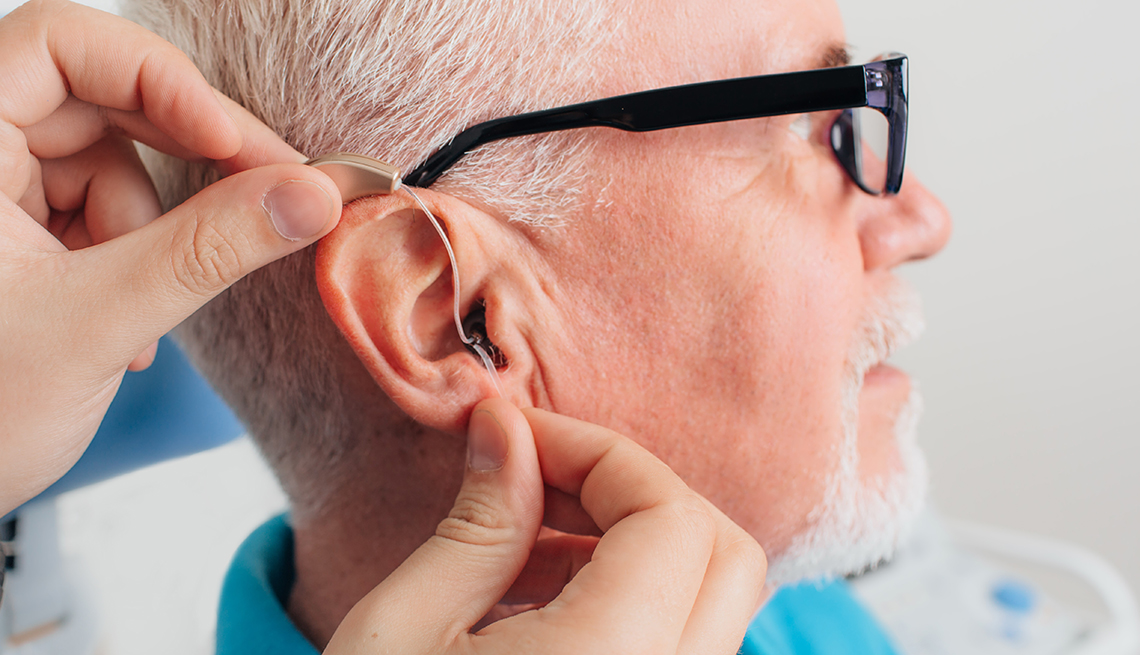
"Some people want more control over their hearing aids and want the ability to make adjustments in real time from their smartphone or smartwatch,” he says. “Other less tech-savvy people often want to rely on the adjustments made by their audiologist and any automatic adjustments made by the hearing aids themselves using AI [artificial intelligence] or machine learning.”
Audiologists recommend a hearing test yearly after getting hearing aids that includes assessment and removal of earwax; daily cleaning of the devices at home to prevent buildup from dirt, oils and earwax; and professional cleaning to remove trapped moisture and debris every three to six months, depending on the type of hearing aid you have.
Features inspired by smartphones
Among the newest innovations now available:
• Artificial intelligence. Algorithms allow the hearing aid to analyze a wearer's environment and the sounds coming in, identify sounds and specific people, and automatically adjust the audio based on the wearer's level of hearing loss and preselected preferences. The hearing aid learns to identify specific voices, so it can focus on the familiar, which reduces the need for a wearer to make manual adjustments throughout the day.
"I think AI and machine learning are the biggest changes we're seeing now in hearing aids. These provide a more personalized listening experience,” Reed says. Artificial intelligence allows a machine to simulate human behavior, and machine learning is a facet of that, allowing a device to learn automatically from what it has encountered in the past.
AI and machine learning also make wearing a cutting-edge hearing aid much easier for people who aren't comfortable with technology, don't want to tinker with a smartphone app or prefer not to visit an audiologist frequently for programming updates or adjustments.
• Bluetooth streaming. Hearing aids with this feature can play audio directly from a compatible Bluetooth device, such as a computer, smartphone, stereo or television. The user hears clearer sound with less interference or feedback.
• Fall detection. Like some new smartwatches, some high-tech hearing aids can figure out whether the wearer has taken a tumble. They then wirelessly connect to the user's smartphone to call 911 or text preselected contacts. For this feature to work, the hearing aid must remain near the smartphone it's paired with.
• Fitness tracker. Instead of using a separate heart rate monitor, pedometer or smartwatch, hearing aids can track movement and the wearer's heart rate, sharing the information with your smartphone.
• Improved directionality. Hearing aids worn in both ears can detect the direction that sound is coming from automatically and reduce or eliminate lesser sounds from other directions, so audio that the wearer wants to hear will be more understandable. The wearer also will be able to figure out the direction of the sound more easily.
• Reduced size. Some of the more recently released hearing aids fit almost entirely within the ear canal. Others that mainly sit behind the ear are smaller, lighter, more comfortable and less visible to others.
• Rechargeable batteries. One of the most sought-after features makes hearing aids more like wireless earbuds. Instead of stockpiling the small batteries, replacing them every three to 10 days and worrying that a pet or small child might try to swallow one, the latest hearing aids contain rechargeable batteries that last all day.
You take the entire hearing aid out at night to recharge it in its holder while you sleep. This eliminates an ongoing expense for batteries and the need to fumble around to insert a battery that is about a quarter-inch to a half-inch in diameter.
Control through your smartphone
In addition to streaming audiobooks, music or phone calls directly from your newer model Android or Apple smartphone, you can customize your hearing aid's settings via a proprietary mobile app. Talking with a friend while walking in the woods requires your hearing aid to perform differently than grabbing lunch at a crowded restaurant.
But people don't always know the settings they need, Reed says. Volume and clarity are what people notice most about sound. Volume comes from low frequencies, and clarity tends to come from high frequencies. But most people with hearing loss have problems with high-frequency sounds.
"If you give someone with hearing loss the ability to make their own hearing aid adjustments, they often adjust the base because it impacts volume,” he says. “They notice an immediate change” and sometimes increased feedback.
"In reality, what they needed was a change in treble and high frequency to improve clarity,” Reed says. “Ideally, you want a hearing aid that knows what adjustments to make automatically using AI and machine learning to achieve optimal levels for you but that also allows you to make minor adjustments via a mobile app."
More on Hearing Aids
"hear" - Google News
December 17, 2020 at 02:58AM
https://ift.tt/2KpvIbh
New Smart Hearing Aids Go Beyond Helping You Hear - AARP
"hear" - Google News
https://ift.tt/2KTiH6k
https://ift.tt/2Wh3f9n
Bagikan Berita Ini















0 Response to "New Smart Hearing Aids Go Beyond Helping You Hear - AARP"
Post a Comment